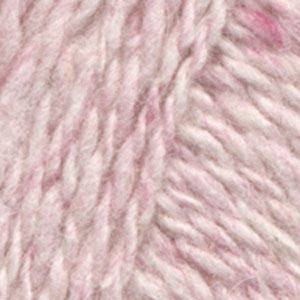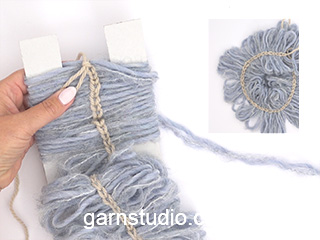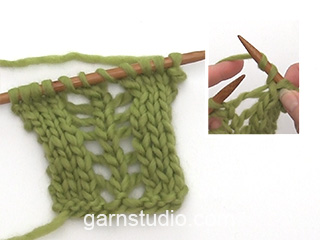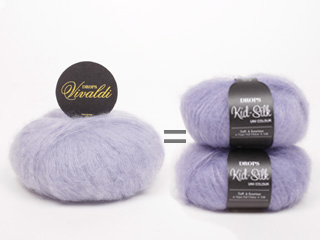DROPS 75-17 |
|||||||||||||
|
|
|||||||||||||
Knitted DROPS jacket with lace pattern in "Angora-Tweed". Crochet Decorative Rose in "Vivaldi" and Boa Scarf in "Italian Velvet".
DROPS 75-17 |
|||||||||||||
|
Knitting tension: 14 stitches x 27 rows with needle size 5 mm, Angora-Tweed and Pattern = 10 x 10 cm. Remember needle size is only a guide! Rib-1: * K3, P4 *, repeat from *-*. Rib-2: * K3, P3 *, repeat from *-*. Ridge/Garter stitch (back and forth on needle): 1 ridge = Knit 2 rows. Pattern: See diagram - M.1. Pattern in diagram is seen from the right side! ------------------------------------------------------- Body: The jacket is worked back and forth with circular needle from mid front. Cast on 138-152-166-180-194 stitches (incl. 1 edge stitch in each side towards mid front) with circular needle size 4 mm and Angora-Tweed. Work rib-1 for 3 cm with 1 edge stitch and 3 knitted stitches in each side towards mid front. On the last row of rib, decrease all P4 to P3 = 119-131-143-155-167 stitches. Change to circular needle size 5 mm and continue with M.1 with 1 edge stitch in each side. Remember the knitting tension! When piece measures 32-33-34-35-36 cm work the next row as follows (from the right side): 28-31-34-37-40 stitches (= right front piece), cast off 3 stitches for armhole, work 57-63-69-75-81stitches (= back piece), cast off 3 stitches for armhole, work 28-31-34-37-40 stitches (= left front piece). Each part is finished separately. Right front piece: = 28-31-34-37-40 stitches. Continue to decrease for armhole in the side every 2nd row: 2 stitches 0-1-2-4-4 times and 1 stitch 2-3-4-3-3 times = 26-26-26-26-29 stitches - NOTE: As you are decreasing, work the stitches which do not fit into the pattern in stocking stitch. Continue with pattern and 1 edge stitch towards armhole. At the same time, when piece measures 38-40-42-44-46 cm decrease for neckline mid front every 2nd row: 1 stitch 10 times - NOTE: Work the stitches which do not fit into the pattern in stocking stitch = 16-16-16-16-19 stitches left on shoulder. Cast off the remaining stitches when piece measures 52-54-56-58-60 cm. Left front piece: = 28-31-34-37-40 stitches. Finish in same way as right front piece, but with decreases for armhole and neck in the opposite side. Back piece: = 57-63-69-75-81 stitches. Continue to decrease for armholes in each side as for front piece = 53-53-53-53-59 stitches left on needle. Continue with pattern with 1 edge stitch in each side. When piece measures 50-52-54-56-58 cm cast of the middle 19 stitches for neck. Then decrease 1 stitch on next row towards neck = 16-16-16-16-19 stitches left on each shoulder. Cast off the remaining stitches when piece measures 52-54-56-58-60 cm. Sleeve: Cast on 56-63-63-70-70 stitches with double pointed needles size 4 mm and Silke-Tweed and work rib-1 for 4 rounds. Change to Angora-Tweed and continue with rib-2, i.e., all P4 decreased to P3 on first round = 48-54-54-60-60 stitches. When piece measures 20 cm change to double pointed needles size 5 mm and continue with M.1 to finished length. (NOTE: There are no increases on sleeve). When piece measures 51-51-50-49-47 cm cast off 6 stitches mid under sleeve and finish working back and forth on needle. Then decrease for sleeve cap in each side every 2nd row: 2 stitches 2-3-2-1-1 times, 1 stitch 3-2-7-11-13 times, then decrease 2 stitches in each side until piece measures 57-58-59-60-59 cm. Cast off the remaining stitches. Assembly: Sew shoulder seams. Left band: Pick up approx. 79 to 97 stitches (divisible by 6 + 1) along the left front piece with circular needle size 4 mm and Angora-Tweed. Work back and forth on needle as follows from the bottom edge (seen from the right side): 3 stitches garter stitch, * K3, P3 *, repeat from *-* and finish with K3 and 1 edge stitch towards neck. When band measures 2.5 cm, cast off with knit over knit and purl over purl. Right band: Work as for left, but after 1 cm work 6 buttonholes evenly spaced on row - the bottom buttonhole should be 1 cm from bottom edge and the top buttonhole 0.5 cm from the top. 1 buttonhole = cast off 1 stitch and make 1 yarn over above the cast off stitch on next row. Neck: Pick up approx. 100 to 110 stitches around the neck (including over the bands) with needle size 4 mm and Silke-Tweed. Work 2 ridges and then loosely cast off. Sew in sleeves – divide the stitches on the sleeve evenly into the armhole. Sew on buttons. Crochet edges: Work with hook size 3 mm and Silke-Tweed around bottom of sleeves as follows: 1 double crochet, * 5 chain stitches, skip 3 knitted or 4 purled stitches, fasten with 1 double crochet in next stitch *, repeat from *-*, finish with 1 slip stitch in første double crochet. CROCHET DECORATIVE ROSE Materials: DROPS Vivaldi from Garnstudio 50 g colour no 03, burgundy. You can also use a left-over of another thin yarn. DROPS Crochet hook size 3 mm. Accessories: Small saftey pin. -------------------------------------------------------- Crochet tip: When working the rose, every 2nd round will be displaced; this is so that the petals on the rose are not directly beneath each other. NOTE: Every new round of chain-spaces is worked at the back of the round already worked. There are 4 "layers" of petals. Start innermost with the smallest petals and finish outermost with the largest. -------------------------------------------------------- Rose: The whole rose is worked with 2 strands Vivaldi and hook size 3 mm. Work 4 chain stitches and form them to a ring with 1 slip stitch. Read the whole of the next section before continuing! Round 1: 6 double crochets around ring. Round 2: * 6 chain stitches, skip 1 double crochet, 1 double crochet in next double crochet *, repeat from *-* a total of 3 times. Round 3: * 1 double crochet, 1 chain stitch, 6 treble crochets, 1 chain stitch, 1 double crochet *, repeat from *-* in each of the 3 chain-spaces from previous round. Round 4: Work slip stitches in double crochets from round 1 as far as middle of first chain-space from previous round, * 10 chain stitches, skip 1 double crochet from first round, 1 double crochet in next double crochet *, repeat from *-* a total of 3 times. The petals will now be displaced so that they are not directly beneath each other. Round 5: * 1 double crochet, 1 chain stitch, 10 treble crochets, 1 chain stitch, 1 double crochet *, repeat from *-* in each of the 3 chain-spaces from previous round. Round 6: Work slip stitches in the double crochets from the first round as far as the middle of the first space from previous round. * 12 chain stitches, 1 double crochet around next double crochet from round 2 *, repeat from *-* a total of 3 times. Round 7: * 1 double crochet, 1 chain stitch, 1 treble crochet, 8 double treble crochets, 1 treble crochet, 1 chain stitch, 1 double crochet *, repeat from *-* in each of the 3 chain-spaces from previous round. Round 8: Work slip stitches in the double crochets from the first round as far as the middle of the first space from the previous round. * 14 chain stitches, 1 double crochet around next double crochet from round 4 *, repeat from *-* a total of 3 times. Round 9: * 1 double crochet, 1 chain stitch, 1 treble crochet, 5 double treble crochets, 3 triple treble crochets, 5 double treble crochets, 1 treble crochet, 1 chain stitch, 1 double crochet *, repeat from *-* in each of the 3 chain-spaces from the previous round. Finish with 1 slip stitch in the double crochet at the beginning of the round. Fasten strand. The rose measures approx. 7 cm in diameter. Fasten a small safety pin to the back of the rose. BOA SCARF Length: approx. 150 cm. Materials: DROPS Italian Velvet from Garnstudio 100 g colour no 01, burgundy. and use: Karisma Superwash, 100% pure new wool, 50 g = approx. 110 m. 50 g colour no 05, black, or a left-over of another medium thick yarn. CARDBOARD: As a template to wind the yarn around, e.g. from a cardboard box or the back of a drawing book. Boa: Draw the template on cardboard with the measurements shown in diagram and cut out – see figure 1 («tegn.» = figure). Mark the center with a line. Make a loop with Karisma and lay it on the center line so that the loop and yarn are as seen in figure 2. Hold with left thumb on Karisma-loop and strand of Italian Velvet at the same time. Wind Italian Velvet around template in a Figure 8 to the right, through middle and around the left, then through the middle to the front, as shown in figure 3. Pull up Karisma-loop and finger crochet 1 chain stitch around Italian Velvet where it intersects. Using thumb and index finger on right hand, pull a strand from ball of Karisma around Italian Velvet and through the loop, and pull up a new loop – see figure 4. Make a new Figure 8 with Italian Velvet and finger crochet with the second loop. Continue in this manner. When the template is full, pull off Figure 8s and just leave last one in place to continue. Make boa as long as you can with one ball of Italian Velvet, approx. 150 cm. The loops are quite loose in each chain stitch and can be pulled out of shape if caught on anything. You may wish to reinforce the finger crochet so that the Italian Velvet loops will not be pulled out – use 1 strand Karisma and sew using back stitch or crochet through boa again, so that the chain stitches are secured. Try to sew through the Italian Velvet-yarn. |
|||||||||||||
Diagram explanations |
|||||||||||||
|
|||||||||||||
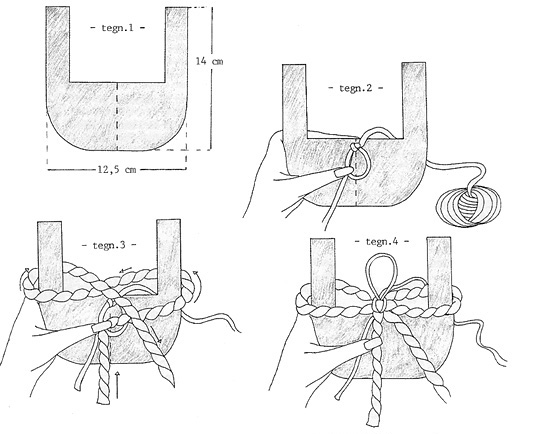
|
|||||||||||||
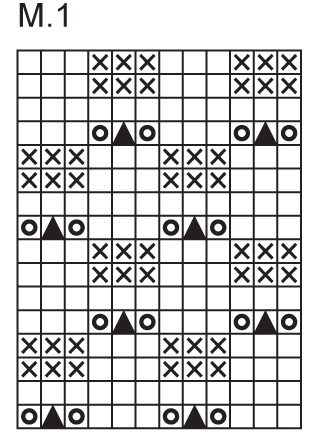
|
|||||||||||||

|
|||||||||||||
|
Have you made this or any other of our designs? Tag your pictures in social media with #dropsdesign so we can see them! Do you need help with this pattern?You'll find tutorial videos, a Comments/Questions area and more by visiting the pattern on garnstudio.com. © 1982-2024 DROPS Design A/S. We reserve all rights. This document, including all its sub-sections, has copyrights. Read more about what you can do with our patterns at the bottom of each pattern on our site. |
|||||||||||||









